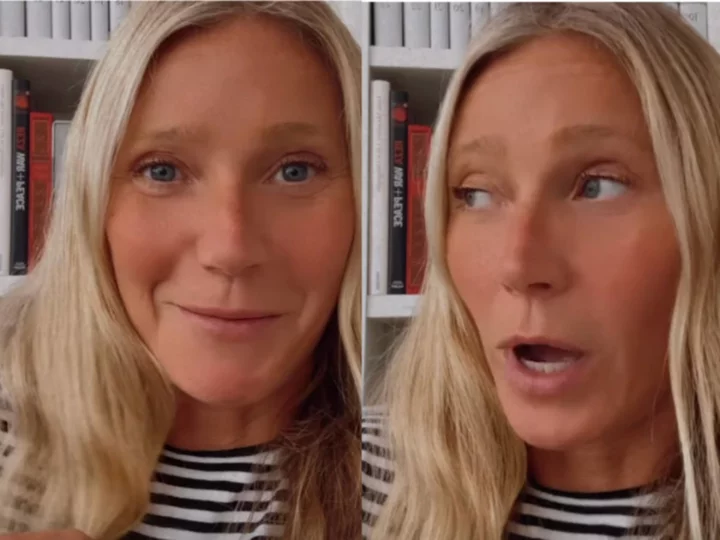
Gwyneth Paltrow says she found being a stepmother ‘really hard’: ‘There’s a lot of landmines’
Gwyneth Paltrow has spoken candidly about her experience as a stepmother to her husband Brad Falchuk’s two children, Isabella, 19, and Brody, 17. On 30 August, the wellness mogul took to her Instagram Story, inviting all of her 8.3m followers to ask her anything. From hair colour inquiries to questions about her late father, Paltrow’s audience didn’t hold back. In fact, one fan forced Paltrow to open up about what it’s been like marrying a spouse who already had two children. “I did find it really hard at first,” the Goop founder admitted. “You know? There’s no book on this. Nobody tells us what to do. And in fact, all of the existing media around what a stepmother is casts us in this evil, villainous light.” “It’s kind of like trying to avoid landmines,” she added. Paltrow married the TV writer in 2018 after four years of dating. She was previously married to Coldplay frontman Chris Martin for 10 years, before announcing their divorce in March 2014. Meanwhile, Falchuk shares his two children with his previous wife of 19 years, Suzanne Bukinik. When the health enthusiast tied the knot with Falchuk, she welcomed Isabella and Brody into her family - with her mini-me daughter Apple, 19, and her 17-year-old son Moses, whom she shares with Martin. The Academy Award-winner acknowledged the difficulties of being thrown into a new family. She pointed out how existing dynamics between each member are tricky to navigate all at once. For her, there was a fear of how becoming a new figure in her stepchildren’s lives would affect everyone. “You’re going into a family with dynamics, and there’s all kinds of fear around loss and what does this new person mean,” Paltrow noted. “But you know for myself, the minute I decided and fully embodied the idea that my step-kids were my kids and I loved them just as much, and I gave them the same rules and boundaries and just kind of wholeheartedly went for it, the easier the whole thing got.” Paltrow’s Instagram confessions come after the A-lister decided to take a social media hiatus earlier this month. In her 2 August post, she was seen sitting below the branches of a tree with the light of the moon peaking in. “Taking this full moon energy with me as I go into a social media break. Going to work on being present,” her caption read. On 14 August, the healthy living advocate broke her social media silence to share a poignant tribute for the renowned artist Clarence Avant. She posted a photograph of them embracing one another, expressing her sorrow over the loss. “You were beloved by so many, including our family who looked forward to every dinner, every drop of wisdom, just the warmth of your presence,” she wrote. Read More Gwyneth Paltrow was asked to film an ad for a probiotic - and the results were chaotic Holly Willoughby channels Gwyneth Paltrow with ‘orgasm anxiety’ blog post Gwyneth Paltrow announces social media hiatus Gwyneth Paltrow was asked to film an ad for a probiotic. The results were chaotic. Marijuana users have higher levels of toxic metals in blood and urine, study finds Rugby star Ugo Monye: Boarding school shaped my career and my personality
2023-09-01 01:47

2023/24 Champions League Group C: Fixtures, results and how to watch
Here are the teams in Group C of the 2023/24 Champions League and all you need to know about the group.
2023-09-01 01:25

Marijuana users have higher levels of toxic metals in blood and urine, study finds
People who use marijuana were found to have higher levels of lead and cadmium in their blood and urine, in comparison to those who do not use weed, according to a new study. The team of researchers at Columbia University analysed data from blood and urine samples collected between 2005 and 2018 as part of the National Health and Nutrition Examination Survey, a program conducted by the National Center for Health Statistics. They looked at samples of 7,254 people who said they had used marijuana in the last 30 days. Participants were examined for levels of heavy metals and 358 people were found to have 27 per cent higher blood lead levels than those who said they didn’t use either marijuana or tobacco. There were also 22 per cent higher levels of cadmium in those marijuana users according to the research, which was published Wednesday in the journal Environmental Health Perspectives. Researchers also found that the urine samples showed similar results. High levels of cadmium can cause stomach irritation, abdominal cramps, nausea, vomiting and diarrhoea, according to Better Health. Researchers found that although tobacco is the main source of cadmium exposure in the general population, the study showed similar exposure levels among cannabis users. “For both cadmium and lead, these metals are likely to stay in the body for years, long after exposure ends,” Tiffany Sanchez, an author of the study and an assistant professor of environmental health sciences at Columbia’s Mailman School of Public Health said to NBC News. As cannabis plants can absorb heavy metals from soil - the new findings demonstrate that heavy metals in cannabis plants can also wind up in the human body. “Previous studies have measured metals in marijuana plants, products, or marijuana smoke,” study authors have said. Lead exposure can be particularly harmful to children and pregnant women. In adults, chronic exposure to lead increases the risk of high blood pressure, heart problems and kidney damage. “Our study wasn’t able to tease apart whether or not self-reported cannabis users were using medical or recreational cannabis, so we can’t say definitively if medical cannabis users specifically had higher metal levels,” Sanchez said as reported by CNN. “This is something that should be evaluated in future studies.” Heavy metals bind to parts of your cells that prevent your organs from doing their job, according to the Cleveland Clinic and symptoms of heavy metal poisoning can be life-threatening and can cause irreversible damage. “Immunocompromised people, such as those going through chemotherapy, may be at greater risk from metal exposure or from other common cannabis contaminants like molds. However, this is very much an understudied area,” Sanchez added. On Wednesday, the Department of Health and Human Services recommended that the Drug Enforcement Administration ease restrictions on marijuana by moving it from Schedule I drug to Schedule III. HHS Secretary Xavier Becerra said on X, the platform formerly known as Twitter, that the agency has responded to President Joe Biden’s request “to provide a scheduling recommendation for marijuana to the DEA.” “We’ve worked to ensure that a scientific evaluation be completed and shared expeditiously,” he added. Senate Majority Leader Chuck Schumer said in a statement that HHS had recommended that marijuana be moved from a Schedule I to a Schedule III controlled substance. “HHS has done the right thing,” Schumer said. “DEA should now follow through on this important step to greatly reduce the harm caused by draconian marijuana laws.” Rescheduling the drug would reduce or potentially eliminate criminal penalties for possession. Marijuana is currently classified as a Schedule I drug, alongside heroin and LSD. According to the DEA, Schedule I drugs "have no currently accepted medical use in the United States, a lack of accepted safety for use under medical supervision, and a high potential for abuse." Additional reporting from agencies Read More Biden health agency recommends classifying marijuana as lower-risk, opening potential for major policy changes Seth Rogen reveals why he smokes marijuana ‘all day, every single day’ Rugby star Ugo Monye: Boarding school shaped my career and my personality Queen Latifah calls for more ‘inclusive healthcare’ for people with obesity As Simon Cowell shares positive therapy experience, how can it help even if you aren’t in crisis?
2023-09-01 00:51

Campbell Soup sees upbeat annual profit on easing costs, snack demand
By Deborah Mary Sophia Campbell Soup forecast annual profit largely above Wall Street estimates on Thursday, encouraged by
2023-08-31 21:55

As Simon Cowell shares positive therapy experience, how can it help even if you aren’t in crisis?
X Factor boss Simon Cowell, 63, has shared that having discovered therapy in the past year, he feels as though “a weight has lifted off my shoulders”. The music mogul, who is behind The X Factor and Britain’s Got Talent, said he wished he had seen a therapist “10 or 20 years ago” in a recent interview with the Daily Mirror. He also shared that the deaths of his parents and the coronavirus pandemic had affected his mental health. Seeking therapy has been transformative for Cowell and it could do the same for you, whether you are in crisis, or just want to learn more about yourself. Cowell has said engaging in therapy had a “super positive effect” on his life and encouraged others to do the same, so here’s what you should know. There are different types of therapy Contrary to what many people may believe, counselling, where you sit and talk through events and reflect, is not the only form of therapy. “There are a whole host of different types of therapies available, from counselling, cognitive behavioural therapy, mindfulness-based cognitive therapy, acceptance and commitment therapy, interpersonal therapy, psychodynamic psychotherapy to eye movement desensitization and reprocessing,” explains psychologist and author of The Self-Care Revolution, Suzy Reading.Each one can have a different role in helping you get to know yourself better, handling trauma, feeling more grounded and coping more day-to-day. Therapy isn’t just for rock bottom Therapy doesn’t have to be a last resort. “When it comes to therapy, there are no hard and fast rules,” says Liz Ritchie, a St Andrew’s Healthcare psychotherapist. “Many people associate seeking help with crisis, but there is no reason why you cannot maintain regular sessions with your therapist. There is now a wealth of evidence that supports that therapy can also be a preventative form of mental healthcare, a little bit like going to a dentist or a doctor. “Life is busy and stressful, which means we don’t often have time to process cross words with a loved one, work altercations or issues with friends and family members.” You’ll understand yourself better You may think you understand yourself totally, but there are always new parts of ourselves to get to know. “Therapy helps us better understand ourselves, our relationships and the world, connecting us with how we feel, and why we might feel as we do. It is a journey of self-discovery, helping us appreciate our strengths and identify our values,” says Reading. It could give you an emotional toolkitIt can be helpful to have “an impartial sounding board to speak openly and honestly and the opportunity to be heard, validated and understood”, says Reading. “Therapy helps us challenge unhelpful thoughts, dispute self-limiting beliefs and can help us create new habits. Therapy is also about developing healthy ways to move through our emotions, creating a fresh toolkit of coping strategies and can be very practical in nature by helping us address specific challenges or goals.” But… it isn’t easy Unfortunately getting therapy is not always easy. If you do not have the financial freedom to be able to pay for a private therapist, you may be faced with long waiting lists and restrictive services. However, NHS therapy is an option and can be really helpful, so be sure to look into the options you can afford near you. Reading recommends checking out BPS and HCPC to find a qualified therapist. NHS resources can be accessed here. If you are seriously struggling with your mental health, and are at risk, please call 999 or the Samaritans on 116 123.
2023-08-31 20:55

Man who lengthened his limbs by three inches feels ‘so much happier’
A Canadian man has had limb-lengthening surgery, costing £25,000, to increase his height from 5ft 7in to 5ft 10in as he was so insecure about his height it caused him to have “suicidal thoughts”, and claims he is now “so much happier” and “confident”. Daniel Farbod, 27, a civil engineer, from Toronto, Canada, has been self-conscious of his height “all (his) life” – when he stopped growing, at age 14, he said it felt “tragic” and like his “first stab to the heart.” Daniel always defined “being masculine” as being tall, and was “ashamed” of himself as he “didn’t feel like a man.” Over time, being taller was all Daniel could dream about, and claimed his height “impacted his mental health so badly” that he was having “suicidal thoughts”. After coming across the unique surgery online, he realised he was “willing to sacrifice time and money to get (his) life back.” So, in May 2021, he had his first procedure in a specialist clinic in Turkey, which involved breaking his femurs, hollowing out the bone, and putting a rod inside the bone with external fixators, pieces of steel on the outside of his legs. Daniel had to turn the fixators with an Allen key every day for over four months, and eventually had his second surgery to remove the fixators after his bones had successfully fused together. When Daniel recovered, he could not “put into words how happy (he) was” and “felt so much more confident”, now, he is sharing his journey on social media to inspire others who are insecure about their height. Daniel told PA Real Life: “I’m really proud of myself for having the surgery. “I was insecure all my life about my height, it impacted my mental health so badly. “I was suicidal, and after admitting that I wanted to take the steps to feel better, and have the surgery, I feel so much better. “I think for other people, it is important to know how tough the surgery and recovery is – it was the hardest thing I’ve ever done, but for me, it changed my life and made me grow not only literally but also metaphorically as a person.” Daniel, who has always been self-conscious about his height, stopped growing at age 14, and became obsessed with finding ways to become taller. He said: “I researched everything from socks and supplements that claimed to increase your height. “I was always insecure and worried about it – I used to go to orthopaedic doctors because I was so scared of not growing. “But when I got to age 14, I stopped and it was so depressing.” When it became clear to Daniel that he was unlikely to grow any more, it took a toll on his mental health and confidence. He explained: “It was so tragic for me, it was like my first stab to the heart. “All my dreams would be about being taller and I had to somehow accept that my height had peaked. “I tried to keep myself busy to manage my thoughts but in 2020 I just couldn’t handle it – I had all of these negative thoughts and suicidal thoughts because I think being masculine, and being a man, means to be tall. “I didn’t feel like a man, I was so ashamed.” Daniel felt as though having limb-lengthening surgery was the only way he was going to feel better, but his parents, who are both “on the shorter side”, did not approve of his decision to have cosmetic surgery. He said: “Everyone was really against the idea because they thought it was not natural and it was changing the way your body is meant to be. “I knew the surgery was going to be tough, but I thought even that pain would be better than having suicidal thoughts. “I was willing to sacrifice time and money to get my life back.” In May 2021, Daniel had his first surgery in a specialist clinic, Live Life Taller, in Turkey, which involved breaking both of his femurs, hollowing out the bone, and putting a rod inside the bone with external fixators – pieces of steel on the outside of his legs. He explained: “I was really scared when I got to the clinic, and the breaking of the bones was the part I was most nervous about in the whole process. “It was crazy to wake up after the surgery – the reality just hit me all at once and I was so happy.” His recovery involved being in a wheelchair and using an Allen key to turn a bolt on the fixators four times a day at 90 degrees to separate the bone segments a little at a time. Daniel continued to do this every day for four and a half months, saying of his painful recovery: “My skin was stretching, my muscles were growing, it was madness. “It took me even longer to recover, they usually say it will take three months, but, my I had nerve issues with my right leg and had to have it broken again. “It was a very tough time.” In September 2021, the external fixators were removed, he explained: “I used a walker and really really slowly I worked up to using crutches. “I couldn’t really tell how tall I was at that point. “It took me at least another three months to be able to stand up.” Mr Farbod went from 5 ft 7 to 5ft 10 and thinks his mental health has dramatically improved as a result. He said: “I couldn’t believe it. I had been dreaming of being a tall man since I was 10 years old, it’s all I’ve ever wanted. “I went through all these sleepless nights, trauma and upset, and I finally achieved my goal. “I can’t even put into words how happy I was, and still am – I felt so much more confident.” When Mr Farbod arrived home, his family were also very happy for him. He said: “They looked after me so much – I could barely get out of bed or bend down for a long time. “They could tell I was so much happier when I recovered.” Now, Daniel shares his journey on Instagram and YouTube to inspire others who are insecure about their height. He said: “I want to show people the reality of the surgery – it’s tough but I want to raise awareness and get men talking about their insecurities.” For support, contact the Samaritans on 116 123, email them at jo@samaritans.org, or visit samaritans.org to find your nearest branch. Read More Charity boss speaks out over ‘traumatic’ encounter with royal aide Ukraine war’s heaviest fight rages in east - follow live 10 slick ways to kit out your student digs 4 essential officecore trends to update your work wardrobe Sickle Cell Awareness Month: What is sickle cell disease and how do you know if you have it?
2023-08-31 16:50

Sickle Cell Awareness Month: What is sickle cell disease and how do you know if you have it?
Almost 300 babies are born in the UK with sickle cells every year, according to the Sickle Cell Society, and the effects of sickle cell disease are believed to impact thousands. Yet, many people may not even know what sickle cells are or what living with the condition means. What is sickle cell disease? In most people, red blood cells are disc shaped and move easily through the blood vessels. But if you have sickle cell disease, your red blood cells are shaped like a sickle (similar to a crescent moon). This stops them moving with ease through the body and blood flow becomes restricted. Sickle cell disease isn’t actually one specific disease – it refers to a group of conditions affecting people with sickle cells, which range in severity.The conditions are inherited and predominantly affect people from African and Caribbean family backgrounds. What are the symptoms of sickle cell disease? Symptoms begin early in childhood and can sometimes be debilitating. How each individual is affected may vary, but the main symptoms are anaemia, an increased risk of infections, and pain. This includes extremely painful episodes called ‘sickle cell crisis’, which happens when blood flow to certain parts of the body become blocked. According to the NHS, these episodes can last for days and require hospitalisation. Other issues are associated with the condition too, including problems with the lungs, delayed growth in childhood, higher risk of stroke, leg ulcers and sight/vision problems.How is it diagnosed? Sickle cell disease is usually picked up during pregnancy or shortly after birth, although a blood test can be given at any time to see if someone has the condition or carries sickle cell genes. In parts of the country, pregnant people will be offered a test to see what the chances are of their child having sickle cells. Infants can be checked for the cells through a heel prick test.How do you treat it? Treating sickle cell disease is usually a lifelong process to help people with pain and to stay as healthy as possible. Treatment takes place in specific sickle cell centres and those living with it are encouraged to take care of their health, no matter the severity of their symptoms. Managing pain is a huge part of treating sickle cell disease. Staying hydrated can be helpful, as well as avoiding sudden temperature changes, like getting into a cold shower or diving into water. According to the NHS, Hydroxycarbamide (hydroxyurea) may be recommended, which is taken as a pill once a day. This can lower the quantity of other blood cells and requires careful monitoring, however. Some people may also be able to have a medicine called crizanlizumab, either on its own or alongside hydroxycarbamide, usually injected into a vein every four weeks. To prevent infections, many people with sickle cell disease will take daily antibiotics. Read More Charity boss speaks out over ‘traumatic’ encounter with royal aide Ukraine war’s heaviest fight rages in east - follow live TikTok has gone wild for adult gymnastics – here’s what you should know Man explains why he swapped veganism for raw meat diet: ‘I feel great’ Rugby star Ugo Monye: Boarding school shaped my career and my personality
2023-08-31 14:55

Barcelona's dream and nightmare Champions League draws
With the Champions League group stage draw set to take place on Thursday 31 August here are the dream and nightmare scenarios for Barcelona.
2023-08-31 01:16

TikTok has gone wild for adult gymnastics – here’s what you should know
Have you always wanted to be able to do the splits or a backflip? Maybe you’ve watched your kids do a gymnastics class and thought, ‘Wow, that looks so fun’. Adult gymnastics is gaining some serious popularity online, with the TikTok hashtag #adultgymnastics getting over 209.5 million views. Influencers such as Anna Archer – who has over 300,000 followers on Instagram and creates content surrounding lots of different fitness experiments – and stunt woman Corinne Nicewick have shared clips of their experiences of trying out gymnastics as an adult. Nicewick, despite being a talented stuntwoman, has shared clips of how challenging she has found the sport, with viewers finding her attempts both funny and encouraging. Gymnastics has put some famous faces in good stead for other fitness-related challenges, with gymnast Beth Tweddle winning the 2103 series of Dancing on Ice and Ellie Downie, GB gymnast taking on the gruelling SAS: Who Dares Wins reality show in 2023.So, what do you need to know before you get involved? How does adult gymnastics work? Can anyone do it? Classes have been steadily cropping up across the UK encouraging adults of all abilities to get involved in gymnastics, and unless you have a health problem or injury that may restrict you from doing so, anyone can get involved. It is not so dissimilar to exercises you may already do like plyometrics (explosive body weight resistance exercises like box jumps), CrossFit or yoga. “Gymnastics is a series of different exercises that test your strength, mobility, flexibility and agility,” says Sofia Zolobova, instructor and gymnastics expert at Gymbox. “It’s also a lot of fun, incorporating lots of different floor, beam and hoop exercises,” she explains. This element of variety can bring a more fun, playful element to your workout routine. What are the health and wellbeing benefits of adult gymnastics? Gymnastics will give your body a really different workout and improve your strength, mobility and balance. “Strength and mobility are both very important as we grow older,” says Zolobova. “Gymnastics uses your own body weight, so not only do you get stronger, you move better. For example, to be able to execute a hand stand you need great shoulder mobility,” she explains. “With our modern tight shoulders, gymnastics can be helpful in improving our posture.” How do you get past being scared? As a kid, doing a cartwheel and taking a tumble doesn’t seem so threatening, but as adults we are all a bit more scared of getting hurt. Instead of falling into the trap of fear, embrace the playfulness of it. Zolobova says: “It’s a really fun way to exercise. It includes handstands, cartwheels and frog jumps, letting you unleash your inner child. It empowers you to do cool tricks as an adult and work up to a certain goal. It’s also a great fear fighter – sometimes you just have to let go and trust yourself.” What should we be careful of in adult gymnastics? Your fitness and flexibility may not progress as quickly as they might have done as a child. “Children are naturally more flexible than adults, so when undertaking gymnastics for the first time keep this in mind. Take things slow and one step at a time – you can always build up strength and flexibility with consistent practice,” explains Zolobova. How do we protect our backs and joints? Putting your back out or hurting your joints is a very real fear as an adult. Zolobova says: “Stretching should never be skimped on and should be thorough and dynamic [involving movement]. It’s also very important to make sure the body is warmed up before undertaking any gymnastic moves, a light jog and jumping jacks are great ways to get the muscles warm fast.”
2023-08-30 21:55

How can I improve my teenager’s low mood?
If there’s one thing associated with teenagers more than anything else, it’s moodiness. But although low mood is extremely common in teens, what’s just as common is that parents don’t know what to do about it. Adolescence is the highest risk period of life to experience depression, and half of adult mental health disorders start before the age of 15, says consultant clinical psychologist Dr Beth Mosley, who provides specialist mental health support to children and their families. “Seeing the signs of low mood in your teen can be worrying if you’re a parent,” she says. “The questions you may ask are likely to be, what are the usual highs and lows of adolescence, and what is something to worry about? Why might my teen be struggling with low mood, and most importantly, what can I do as a parent to help if my teen is feeling down and showing signs of disengaging with life?” Mosley, the author of new book, Happy Families, which is about the most common issues affecting children’s mental health and how parents can help, says although everyone will, at some point, experience low mood, sadness, irritability and loss of interest in things they enjoy, usually such feelings are linked to problems in life. But changes associated with puberty, and brain restructuring, mean adolescents are especially vulnerable to mental health problems, says Mosley, who explains: “These changes increase the possible impact of life stressors and, thus, their vulnerability to mental health difficulties. “The brain changes in adolescence mean teens feel emotions more intensely – both the highs and lows – meaning it’s not unusual to see them experiencing waves of low mood, particularly in the face of challenges.” She says if a teen’s low mood doesn’t go away, and prevents them doing the things they need to, like schoolwork and spending time with others, it would be wise to consider seeking help. The teen’s school may be able to suggest local support. But she adds: “Whether your teen experiences passing or more persistent low mood, the good news is that the brain is flexible and ripe for learning in adolescence, so there’s a lot we can do to support our teens when they’re experiencing low mood. “Importantly, this support will likely improve your relationship with your teen, and help protect them from developing mental health difficulties in adulthood.” If your teenager’s mood is low, these are the things Mosley says might help them… Encourage them to do what’s important to them When someone feels low, they tend to do less of what’s important to them, meaning they get less rewards from life and feel lower, Mosley explains. This is the low-mood cycle. Conversely, by doing more of what’s important to them regularly, they get more reward from life and start to feel better – this is the feel-good cycle, she says. So rather than a teen waiting until they feel better to do the things that are important to them, low-mood teens should do them now to break the low-mood cycle. “Determining what activities they can do more of and what unhelpful activities to do less is a key first step,” says Mosley. “You can support your child by providing more opportunities to do what’s important to them and increasing access to rewards. Give them practical support to do the activities they enjoy, provide encouragement.” Communicate better with them Mosley says that low mood can make it difficult for teens to communicate, but parents learning key communication skills can support how they communicate with their teens and, in turn, help improve their mood. She says being careful how you say things, through tone of voice and nonverbal body language, is important, as teens are more sensitive to criticism and negative social feedback. But there are six communication skills in particular that parents should try to use. They are… Picking the right time to have a conversation. “Open and honest conversations are most likely to happen when we’re feeling calm and not under pressure,” says Mosley, explaining that it’s important to be aware of when your teen isn’t in the right frame of mind for a difficult conversation, and to learn to respectfully pause the conversation and reschedule it for a better time. Starting a sentence with ‘I’ rather than ‘You’ can make a huge difference, explains Mosley, who says starting with ‘You’ often has a blaming tone and makes the teenager defensive and stops them from listening, whereas starting with ‘I’ can explain how you’re feeling, which can’t be disputed and starts a whole different conversation. Instead of over-generalising and using words like ‘always’ or ‘never’, Mosley says it’s much better for parents to be specific and provide an example of a recent event, rather than things that have happened over months or years. She says over-generalising is more likely to make teens feel awful, and less likely to spark a collaborative conversation. Imagining how a young person might feel in/about a certain situation can also help, she says. “Understanding someone else’s point of view, and expressing this to them, can make it easier to have a collaborative conversation and avoid an argument,” she explains. “When we’re particularly worried about our children, thinking about how they feel can sometimes help us connect with them.” If you go into a conversation with your child knowing what you want from it but being aware you might not get it, be prepared with some alternative solutions, Mosley advises. “Having a few solutions in your back pocket before you go into a discussion enables you to show you’re willing to compromise so you don’t get stuck in a stalemate situation,” she says. Although you may not initially get the response you hoped for from your child when you try a new way of communicating with them, it’s vital to persevere, stresses Mosley, who explains: “With these communication hacks we should begin to see communication with our children become healthier and more productive.” Tackle your negative thoughts and help your teenager do it too Mosley advises parents to reduce the habit of getting stuck in negative thinking by trying these tactics, which she suggests should be shared and modelled to teens. Remember it’s just a thought and it doesn’t mean it’s real. “Remind your teen that thoughts are not facts, they are ideas and they don’t predict the future,” says Mosley. Let negative thoughts come and go, rather than fixating on them and becoming overwhelmed, she advises, and take the power out of the thought by sharing it with others. “Getting another viewpoint can stop unhelpful thoughts growing in magnitude,” she says, and suggests parents provide opportunities for teens to share their thoughts with them, on car journeys and walks etc. As many young people get stuck on social media, dwelling on distressing thoughts, Mosley suggests: “Help your teen notice this cycle and learn the art of moving to another activity, even if it’s just moving to a different room or doing some physical activity.” She adds: “If your teen is feeling negative and self-critical, move away from nagging and towards helping them refocus their energy on something they enjoy and/or resolving the underlying problem.” Happy Families: How to Protect and Support Your Child’s Mental Health by Dr Beth Mosley is published by Bluebird on August 31, priced £18.99. Read More Charity boss speaks out over ‘traumatic’ encounter with royal aide Ukraine war’s heaviest fight rages in east - follow live Maya Jama and Stormzy: Can you make it work with an ex? 12 smart ways to save money on everyday back-to-school costs 9 ways to make dark rooms look lighter
2023-08-30 15:24

Drinking alcohol does not result in ‘beer goggles’ making people look more attractive, study says
When it comes to approaching someone you like at a bar, it may be more a case of alcohol giving you liquid courage than “beer goggles”, researchers say. A new study suggests drinking alcohol makes people more likely to approach someone they already find attractive, but does not make others appear more attractive. Some people argue that intoxication makes others seem better-looking – but according to the researchers, this has not been systematically studied. Past research typically had people simply rate others’ attractiveness while sober and while intoxicated based on photos. But the new study added the possibility of meeting the people being rated. The study, led by Molly Bowdring of the Stanford Prevention Research Centre, Stanford University, in the USA (affiliated with University of Pittsburgh at the time of this study), and her dissertation adviser, Michael Sayette, involved 18 pairs of male friends in their twenties. The men were brought to the laboratory to rate the attractiveness of people they saw in photos and videos. They were also told that they may be given the chance to interact with one of those people in a future experiment. After the ratings were given, the men were asked to pick those who they would most like to interact with. Pairs of men visited the lab on two occasions – on one occasion they both received alcohol to drink – up to about a blood alcohol concentration of .08 per cent, the legal limit for driving in England, Wales and Northern Ireland, and the United States, and on the other occasion, they both received a non-alcoholic drink. Friend pairs entered the lab together in order to mimic social interactions that would typically take place in a real drinking situation. The researchers say they did not find evidence of beer goggles – whether or not the men were intoxicated had no effect on how good-looking they found others. Professor Sayette, from the University of Pittsburgh, said: “The well-known beer goggles effect of alcohol does sometimes appear in the literature, but not as consistently as one might expect.” However, according to the findings, drinking alcohol may affect how people react to those they find attractive in a different way. The researchers found it impacted how likely the men were to want to interact with people they found attractive. When drinking, they were 1.71 times more likely to select one of their top-four attractive candidates to potentially meet in a future study compared with when they were sober. The researchers suggest alcohol may not be altering perception but rather enhancing confidence in interactions, giving the men liquid courage to want to meet those they found the most attractive. According to the researchers, the findings could have implications for therapists and patients. Prof Bowdring said: “People who drink alcohol may benefit by recognising that valued social motivations and intentions change when drinking in ways that may be appealing in the short term, but possibly harmful in the long term.” The findings are published in the Journal of Studies on Alcohol and Drugs. Read More Yewande Biala thought she was unique in never having had an orgasm – then she made a film about it The dish that defines me: Evelin Eros’s rum cake Woman adopts husband’s ex-wife’s son after growing up in foster care herself Charity boss speaks out over ‘traumatic’ encounter with royal aide Ukraine war’s heaviest fight rages in east - follow live
2023-08-30 15:15

Nobody Loves Watching Viktor Hovland Thrive More Than the Norwegian Golf Announcers
Such genuine joy.
2023-08-30 04:26
